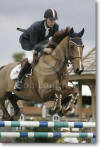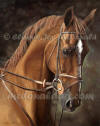
Ian Millar

 |
Featured Rider Ian Millar |
 |
For more than three decades, Ian Millar has been at the forefront of the
Canadian equestrian scene. He has made more than 80 Nations Cup appearances and
has been a member of every Olympic and nearly every Pan-American Games team
since 1971. With numerous medals and over 130 Grand Prix and Derby victories,
Millar is one of the world's most successful riders.
Millar's greatest victories came aboard his most prized mount, the legendary Big Ben. After teaming up in 1984, Big Ben and Millar became the only horse-and-rider combination to win two World Cup finals with back-to-back victories, in 1988 and 1989. They were also the first to claim the World Cup by winning all three segments of the competition. In both 1987 and 1991, they won the du Maurier Ltd. International at Spruce Meadows in Calgary, the world's richest Grand Prix event.
Big Ben and Millar represented Canada in more than 30 Nations Cup events
and were members of seven winning Nations Cup teams. They competed in three
Olympic Games and won two Pan-American gold medals. Among
Before retiring the horse from competition in 1994, Millar took Ben on a
cross-country tour to bid farewell to his loyal fans. Big Ben then settled down
at Millar Brooke Farm near Perth, Ontario, where he lived out a happy and active
retirement until a bout of colic led to his death in 1999.
"Big Ben is ours in trust," Millar said. "He really belongs to Canada.
He touched the whole country." Big Ben will be remembered not just as a
successful show jumping horse but as a national icon and a Canadian treasure.
For his achievements, Millar
received the Order of Canada in 1986. He was also named
 |
 |
 |
Career
Highlights By Date
1984:
Demonstrating exceptional talent, Big Ben went from a small jumper class to
preliminary, intermediate, open and then grand prix in one season.
1984:
Los Angeles Olympics, fourth-place Canadian Team
1986:
Ian Millar awarded the Order of Canada, and the first Canadian rider to ever
be ranked #1 in North America. He was the leading international rider at the
Royal Winter Fair in Toronto.
1987:
Won the $ 250, 000.00 1987 du Maurier International
1987:
Individual and Team Gold medalists at the Pan-American games 1987
Indianapolis US. Ian Millar ranked first in the world in show-jumping by l’Annee
Hippique
1988:
Participated in the Seoul Olympics in 1988, and then won the World Cup Finals
in Goteborg, Sweden
1989:
First in the World Cup in Tampa, Florida. Big Ben the first horse to win two
consecutive World Cup Finals back-to-back. Big Ben and Millar were the first
horse-and-rider combination to win all three phases of the World Cup. Ranked
first in the world in show jumping by l’Annee Hippique again.
1990:
Ian Millar suffers a head injury with concussion that prevented him competing
in the World Equestrian Games in Stockholm, Sweden. Big Ben suffers two bouts of
life-threatening colic.
1991:
Ian Millar and Big Ben win the CN International (formerly the du Maurier)
1994:
Big Ben Retirement Tour
1999:
Big Ben passed away
2005:
Sunday May 22, Big Ben Sculpture to be unveiled.
 |
Featured Breed The Morgan |
 |
The Morgan is one of the earliest
horse
breeds developed in the
United States.
Tracing back to the stallion
Figure,
later named
Justin Morgan
after his best-known owner, the breed excels in many disciplines, and is known
for its versatility.
Breed characteristics
The Morgan horse is compact and refined in build,
with strong limbs, an expressive face, large eyes, well-defined withers, laid
back shoulders and a well arched neck. There is officially one Breed Standard
for Morgan type regardless of the discipline or bloodline of the individual
horse.
Registered Morgans come in a variety of colors although they are most
commonly
bay,
black,
and
chestnut.
Less common colors include
gray,
palomino,
roan,
cremello,
perlino,
dun,
buckskin,
and
silver dapple.
Also present are three of the
pinto
color patterns:
sabino,
frame
overo,
and splash
overo.
The
tobiano
pattern has not been noted in Morgans. The breed standard ranges from 14.1-15.2
hands (1.45 to 1.57 meters) with some individuals over and under. Morgans under
14.2 are eligible for registration with the National Morgan Pony Registry and
can be shown in open "Pony" competitions, even though they are technically
horses, regardless of height, and are usually exhibited as such.
Breed history
Justin Morgan
All Morgans trace back to a single
foundation sire,
a stallion named
Figure,
who was born in West Springfield, Massachusetts in 1789.. He was at one time
owned by a man named
Justin Morgan.
The horse later came to be identified by the name of this particular owner, and
"the Justin Morgan horse" also gave its name to the breed.
Figure is thought to have stood about 14 hh (1.42
m), and to have weighed about 950 lb (430 kg). He was known for his prepotency,
passing on his distinctive looks, conformation, temperament, and athleticism. He
died in 1821 at the age of 32 and is now buried in
Tunbridge, Vermont.
Many myths surround Figure and Justin Morgan. The popular children's
book, Justin Morgan Had a Horse by
Marguerite Henry,
perpetuated some misconceptions about the breeding of Figure (called "Little Bub"
in the book) and his early life. A movie about the pair was also made by
Walt Disney Studios
in 1972, which also took liberties with the depiction of events.
Continuing the Breed
The breed's trotting ability made it a favorite for harness racing in the 1840s. Morgans were also used in the Civil War as cavalry mounts, including Sheridan's "Rienzi" and Stonewall Jackson's "Little Sorrel". In the post-civil war era, Morgans were also used in the Pony Express and as mounts for the cavalry in the western United States. The only survivor of the Custer regiment from The Battle of Little Bighorn was the Morgan-Mustang mixed breed horse Comanche.
The first volume of the Morgan Horse Register was published in 1894. In
1907, the US Department of Agriculture established the U.S. Morgan Horse Farm in
Middlebury, Vermont on land donated by Colonel
Joseph Battell
for the purpose of perpetuating and improving the Morgan breed. The breeding
program aimed to produce horses that were sound, sturdy, well-mannered, and
capable of performing well either under saddle or in harness. The Morgan Horse
Farm was transferred from the USDA to the Vermont Agricultural College (now the
University of Vermont) by Public Law 26 (S. 271), approved by Congress on May 7,
1951.
More than 132,000 Morgan Horses have been registered. The stud book was
closed in 1948 in an effort to preserve the breed. The Morgan has also
influenced several other breeds, including the
Standardbred,
Tennessee Walker,
American Quarter Horse,
Missouri Fox Trotter,
Racking horse,
and the
American Saddlebred.
Nearly 90% of Saddlebred horses today have Morgan blood.
The Morgan Horse has a
horse show
circuit for that breed only. It consists of all levels of riding and all
disciplines. Wins at regional championships qualify competitors to compete in
Oklahoma City at the Morgan Grand Nationals. The first national Morgan Horse
competition was held in 1973 in Detroit, and is now held each October in
Oklahoma City, OK. In addition to the Morgan Grand National, there are 10
regional championship shows and many other official (referred to as "Class A")
shows. Morgans also compete in all-breed shows,
4-H
shows, and other events.
At class A breed shows, Morgans compete
In Hand,
English Pleasure,
Park,
Western pleasure,
Carriage Driving,
Pleasure Driving,
Hunt Seat
(including
hunter
and
jumper
classes over fences),
Trail,
Roadster,
Parade,
Reining,
and
Dressage.
In under saddle classes, performance is the primary judging criterion, though in
some classes
conformation
may also be considered. In-hand classes only consider
conformation.
The Morgan is also able to perform in the
Olympic
and internationally-recognized
FEI
disciplines, which include (show
jumping,
dressage,
eventing),
and
combined driving,
making the Morgan a versatile breed of horse.
State Symbols
In 1961, the Morgan horse was named the official state animal of
Vermont.
In 1970, the Morgan horse was named the official state horse of
Massachusetts.
 |
 |
 |
Vermont Morgan Horse Association Site
|
|
|